Research overview:
My research focuses on understanding the physical processes in industrial and natural flows using advanced numerical simulations (e.g. direct numerical simulations or particle resolved simulations) and analytical tools. My research interests are in laminar and turbulent flows that are complex due to the presence of either density stratification or solid particles.
Particle-laden flows:
Many natural and industrial flows are laden with solid particles. The applications may range from dense suspensions to turbulent flows carrying particles significantly smaller than the Kolmogorov length scale of the flow. We have studied several applications of such flows in the past.
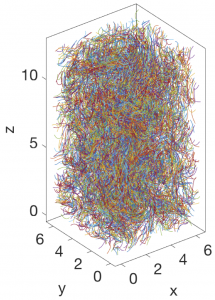
Inertial settling of flexible fibers: We are currently investigating the interactions of flexible fibers with a background flow and with other fibers in dilute and semi-dense suspensions. The results of this study will help us understand better the constitutive laws used in the theoretical studies of the same processes.
Collaborators: Mark Martinez (UBC), Luca Brandt (KTH), Arash Alizad-Banaei (KTH)
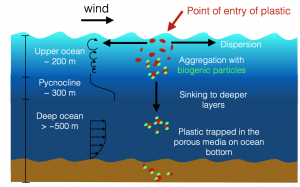
Aggregation and dispersion of microplastics in upper-ocean turbulence:
Microplastics can settle from the surface to deeper layers of the ocean and spread in the entire ocean through their aggregation and/or bio lm formation with biogenic particles. Aggregation and disaggregation of particles of different sizes are important mechanisms that determine the transport of organic and inorganic material in the ocean. Microplastics can form aggregates with particles of the same type (homoaggregation) or with other types of particles (heteroaggregation). We are interested in studying the rate of aggregation/disaggregation of microplastics for different particle sizes, types and under different flow conditions.
Collaborators: Lluís Jofre (UPC), Anirban Guha (Dundee)
Settling of polydisperse and non-spherical particles in quiescent and turbulent flows: While the particle settling problem is a well-studied field of research, the effects of particle polydispersity, non-sphericity and interactions with turbulence are still not well understood. Each of these questions however pose a challenge for the transport of particle and fluid mixtures in industrial settings. We are using numerical simulations to gain a better insight into each of these effects.

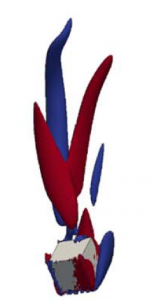
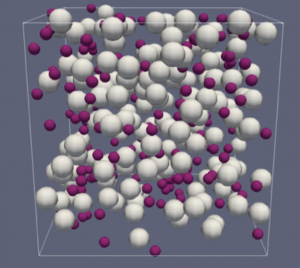
Settling of non-spherical and bidisperse particles in a quiescent flow
Rheological properties of suspensions under shear: In this study, we examine the effective viscosity and diffusion coefficient of a suspension of spherical particles subject to a constant shear rate. Particles with higher inertia, that represent many real-world examples, exhibit a distinctively higher effective viscosity and diffusion coefficients.
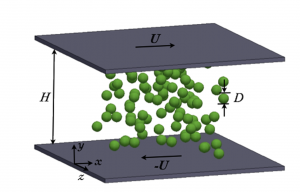
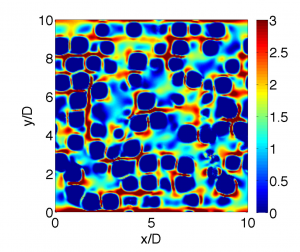
Microstructure of shear stresses in the suspension of spherical particles (Rahmani et al. 2018, PoF)
Heat transfer in particle-laden turbulent flows:
Solid particle solar receivers: The solar energy can efficiently be harvested by concentrating the solar radiation on a mixture of gas and fine solid particles with high absorptivity and thereby extracting energy from the heated mixture. However, a profound understanding of the couplings between the particle concentration, the turbulent flow and the heat transfer from particles to the gas phase is required prior to designing the solid particle solar receivers at large scales. Here, we examine the effects of particle polydispersity on the thermal performance of the system.
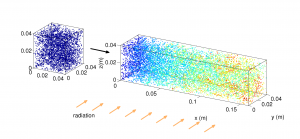
Radiative heat transfer in turbulent flows laden with polydisperse particles (Rahmani et al. 2018, IJMF)
Density-stratified flows:
An important mechanism for mixing in oceanic and atmospheric flows and in sheared mixing layers is the development and turbulent breakdown of shear instabilities, or Kelvin-Helmholtz instabilities, the more commonly observed type of shear instability. We have been interested in investigating mixing properties in density-stratified shear flows.
Mixing transition: As the Reynolds number increases, the mixing behaviour transitions from diffusion-limited to entrainment-limited. At sufficiently high Reynolds numbers the amount of mixing induced by shear instabilities should reach a plateau. However this trend can be altered by the pairing of two adjacent vortices and its significant implications for entrainment and mixing.
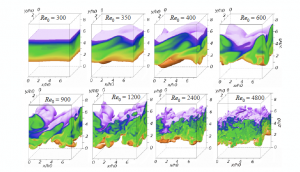
Mixing transition in turbulent Kelvin-Helmholtz billows.
(Rahmani et al. 2014, JFM)
Prandtl number effects: The Prandtl number, the ratio of kinematic viscosity to molecular diffusivity of the stratifying agent (typically salt or heat), can vary over three decades in natural and industrial flows. High Prandtl numbers result in very sharp density interfaces and pose an extreme challenge for numerical simulations. In high Prandtl number flows mixing occurs at a slower rate, but the flow remains energetic for a longer period of time. We are interested in understanding how these two factors interplay to determine the amount and efficiency of mixing in various environmental and industrial flows.
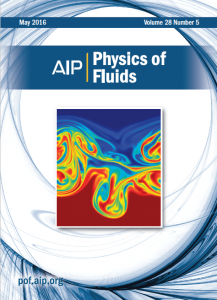
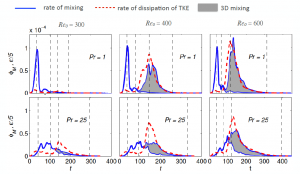
The effect of Prandtl number on mixing at different stages of the KH billow life cycle.
(Rahmani et al. 2016, PoF)
